Preprint
Article
The Visual Behaviour of the Cyclist: The Comparison Be-Tween Simulated and Real Scenario
Altmetrics
Downloads
156
Views
53
Comments
0
A peer-reviewed article of this preprint also exists.
This version is not peer-reviewed
Submitted:
25 February 2023
Posted:
27 February 2023
You are already at the latest version
Alerts
Abstract
Cyclists are one of the main categories of road users particularly exposed to accident risk. The increasing use of this ecological means of transport requires a specific assessment of cyclist safety in terms of traffic flow and human factors. In this study particular visual tracking tool has been used in order to highlight not only the main critical points of the infrastructure, where a high level of distraction is recorded but also the various interactions with different road users (pedestrians, vehicles, buses, wheelchairs, cyclists). In order to confirm the critical points of the infrastructure and the trend of workload, a similar circuit was reproduced in a bicycle simulator, which also allowed a meaningful comparison of cycling behaviour. The cycling performance was also evaluated both from an objective point of view, with the count of frames related to each category of visualization, and a subjective one, through the questionnaires. The results show the crossing as a critical point because of only 4/3% fixation for both simulated and real tests in order to confirm the significance of the comparison between the two experiments. The high attention rate resulting from frame-by-frame analysis also points to a clear difference in the perception of users, who feel with a low workload.
Keywords:
Subject: Engineering - Civil Engineering
1. Introduction
Studying visual behavior means evaluating the sequence of interactions, called 'visual events', between the beholder and the sighted. Observe the movements of the gaze and analyze how the individual can reach certain levels of attention, defines visual behavior in relation to specific actions or scenarios determined in the external environment (Ahlstrom et al., 2013; Kang, 2013; Massey et al., 2020; Wilson & Bobick, 1995).
One of the traditional visual analysis methodologies widely used is the heuristic evaluation. It allows to record the opinions and emotions of people towards a certain task, based on subjective feedback; unfortunately, it does not describe the problems encountered during the action objectively (Cheng, 2011). For this reason, it is necessary to use eye-tracking technology thus obtain an objective calculation of the mechanisms of human vision used in different fields, such as neuromarketing, literacy processes, psychology, medicine and driving behavior (Ryerson et al., 2021; Villing, 2015). It permits to highlight the most relevant visual events, considering what and how long a subject is observing, in addition to recording the contraction of pupils, which are clear signs of cognitive input for the variation of the workload. In particular, this technology studies visual behavior to understand cognitive and emotional processes, providing theoretical and conceptual approaches.
One of the main advantages of this technique is the manageability of the instrument, i.e. innovative glasses, which not only allow the acquisition of information about the view but also provide data on brain function continuously. However, an objective evaluation of the point of view, extrapolated by an eye-tracking system, does not exclude a psychological evaluation, just as important as the subjective perception (Bucchi et al., 2012; Khan and Lee, 2019; Recarte and Nunes, 2003, 2000). It is also possible the use questionnaires or interviews to acquire information regarding the perception, the workload and the effort of the individual to perform a certain action; this allows to extrapolate first the behavior and then the comprehensive psychological framework (Alm and Nilsson, 1994; Nabatilan et al., 2012; Ryerson et al., 2021).
1.1. Eye tracking applied to road safety
Nowadays eye tracking is an analysis method largely developed in the field of mobility. The view, in fact, represents the source of 90% of the information needed to drive; organizing and deciphering the data coming from the external environment allows to establish of the basic parameters for safe driving.
The eyes are the most stimulated and stressed organs while driving, as they have the task of collecting primary stimuli coming from the controls of the car, management of road warnings and interactions with other road users (Nabatilan et al., 2012). In addition, the road user modulates his behavior by considering not only his habits but also external factors. Therefore, it is essential to study the trend of the gaze, through an eye-tracking system, to define useful parameters for road safety (Wang et al., 2017). One example is the factor of attention and, consequently, distraction. Visual attention imparts awareness of the outside environment and it contrasts with the concept of distraction, which interferes with driving performance (Caird et al., 2008; Liang and Lee, 2010). Driver distraction is defined as a variation of attention, followed by temporary concentration on non-driving-related actions; this results in a reduction in performance quality, causing possible risk situations (Beratis et al., 2017; Regan et al., 2011). Therefore, driver distraction is caused by the use of secondary tasks that take the eyes off the main job (Beanland et al., 2013; Gordon, 2005; Wang et al., 2017). When the user manages primary and secondary tasks simultaneously, an important factor becomes relevant: the driving experience. According to Crundall (1999), experienced drivers can capture visual strategies that depend on the complexity of maneuvers and alignment, whereas less experienced drivers have a lower amount of information leading them to be in more dangerous situations (Kass et al., 2007). Among the main secondary tasks responsible for inattention driving is the use of a mobile phone (Hancock et al., 2003). Many researchers underline that mobile phones affect performance negatively; in fact, the visual-manual activities compromise the duration of the gaze on the area of interest, reducing it considerably (Bao et al., 2014; Fitch et al., 2015).
For users, there are two important aspects during the driving action: their psychology, with the perception of the outside world, and their behavior in relation to road users. Therefore, it is necessary to understand which elements are most influential while driving, considering attention and inattention, and which can compromise the level of road safety to carry out an analysis with an eye tracker tool. Crundall (2006) studies the percentage of the time spent observing the surrounding scenario; in fact, it is about 20-50% of the total time, thus highlighting more views for distracting items. Numerous studies examined the physical elements of the road that can be a hindrance to the driver’s view or an obstacle for vehicles going off the road (Costa et al., 2019). As part of Human Factors, in fact, one of the crucial elements to consider is the study of eye-catching objects, that is the elements present in the road layout that could modulate the driver’s attention, according to their positioning. In the bibliography, in fact, one of the objects analyzed is represented by the billboard; considering the position, symmetrical or asymmetric, the path or the impact of color, it could represent a possible distraction factor for the driver, which would induce high-risk situations (Decker et al., 2015; Dukic et al., 2013; Stavrinos et al., 2016). The lack of clarity of the route is the second aspect that can compromise road safety in relation to an inconsistent design of infrastructure away from the concept of 'self-explanatory roads'. This type of road, also defined as user-friendly, allows to identify possible critical points with an appropriate advance for speed modulation (Mackie et al., 2013; Mantuano et al., 2017; Schepers et al., 2014; Theeuwes and Godthelp, 1995; Walker et al., 2013; Walker et al., 2013; Rupi and Krizek, 2019; Kovácsová et al., 2018; Schepers et al., 2011; Robbins and Chapman, 2018, Vignali et al., 2019).
1.2. The visual behavior of road users
The analysis of visual behavior is also useful for observing the mutual relations between road users (von Stülpnagel, 2020). Sometimes, the driver’s behavior and level of attention translate into a 'black event', which happens when the driver does not perceive other road users as a real danger, or when a user makes incorrect considerations about the user’s future actions (Räsänen et al., 1999; Summala et al., 1996). This type of event is particularly frequent with the interaction between vehicles and bicycles. Cyclists, in particular, are the weakest users, most exposed to the accident risk factor for several reasons (Walker, 2005; Martínez-Ruiz et al., 2014; Atkinson et al., 1983; Von Stülpnagel, 2020b; Vansteenkiste et al., 2014; Miah et al., 2020; Raser et al., 2018). First of all, a cyclist’s field of vision is far wider than a driver's car (Vansteenkiste et al., 2014; Fraboni et al., 2018; Pai and Jou, 2014; Wu et al., 2012). In addition, the cyclist is a 'direct victim' of weather conditions that could compromise visibility and balance, considering the road surface features (Schepers and den Brinker, 2011). However, the factors that most adversely affect the rider’s performance are the interactions with vehicles and infrastructure (Von Stülpnagel et al., 2020). This article, in fact, illustrates the visual behavior of the driver in relation to these two important aspects.
In many cities, the use of bicycles is becoming more widespread, highlighting several positive effects in terms of environmental sustainability, so it is useful to deepen the aspects that could affect the performance of the cyclist, to achieve the future of cities as cycling-friendly (Mantuano et al., 2017). In this perspective, the fulfillment of this experimentation, through an innovative tool that is the Mobile Eye Tracker, allowed defining of the visual and driving behavior of cyclists objectively. In particular, the innovation of the research lies in the comparison between these behavioral data extrapolated from a bicycle simulator and recorded on-site.
Simulators are useful to assess how the user lends himself to certain issues, such as learning to drive, testing new road features, and conducting road safety investigations (Godley et al., 2002; Pieroni et al., 2016). The main advantage of bicycle simulators is the possibility to create different situations and especially the desired conditions in relation to research and avoid the risks associated with a real environment (O'Hern et al., 2017). In order to determine the most effective comparison, a scenario was introduced with the same characteristics as the real one, located in Stockholm. The use of the PICS-L bicycle simulator allows the reproduction of the circuit with functional and mechanical features. In fact, it is one of the most effective simulators in the world that, for example, differs from the KAIST interactive bicycle simulator, as it provides not only the scenery but also simulates vibrations and skids that typically have on the road (He et al., 2005; Kwon et al., 2001; Herpers et al., 2008; Törnros, 1998; Walker et al., 2017; (Harbluk et al., 2007; de Waard et al., 2015; Jiang et al., 2021; Planek et al., 2015; Shinar et al., 2005; Kovácsová et al., 2018; Schepers et al., 2011; Gadsby et al., 2020). The results have led to important evaluations that are excellent cues both to evaluate the critical points of the infrastructure and to elaborate the levels of attention depending on the type of road.
2. Method
2.1. Experimental Procedure
40 users were recruited for testing. No participants wear glasses or lenses to obtain a homogeneous sample, which could avoid possible artifacts in eye-movement monitoring. 20 of them were engaged for the on-site test (Mage =35.15; SD=±13.7) and 20 users for the simulator experiment (Mage =27.47, SD=±4.5). All participants have ridden the same route: one of 4 km located in the north of Stockholm (Sweden) and the other reproduced in the simulator (the simulator route is half Stockholm route because of technical limitations). The circuit is divided into four zones according to the characteristics of the infrastructure and the presence of specific types of users: Zone 1 (A and B) represents a promiscuous cycle and vehicle route, without specific separation signals; Zone 2 comprises a carriageway where part of the road has been designated as a cycle lane, divided by horizontal road markings; Zone 3 is a pedestrian and cyclist-friendly route surrounded by car parks (Figure 1) (Shoman et al.,2022).
The first trial was on-site. The participants were involved in a road test where the start and finish points coincided with the laboratory of the Royal Institute of Technology in Stockholm (KTH). All participants were asked to sign a standard consent form including brief details about the experiment, the data collected and the following analysis. They were obliged to wear a helmet and follow the circuit indicated on the GPS placed on the handlebar of the bicycle. On the other hand, the simulator test was performed by making a round trip of 2+2 km i.e. two laps of the course: the first focuses on adaptation to technologies whereas the second underline the evaluation of the test. After completing the cycling session, participants were asked to fill in two questionnaires, in order to evaluate their subjective perception: the NASA task low index, and the disease questionnaire. The first questionnaire consists of six categories of assessment: mental question, physical question, temporal question, performance, effort and level of frustration. Through the average value, it was possible to derive a subjective assessment of the workload perceived during a test of the scores of each category declared by the participant. It has been shown that the NASA TLX questionnaire is a good alternative to the use of electroencephalography (EEG) and allows to have a significance of the species values if administered before and after the test (Cao et al., 2009). The use of such questionnaires has been fundamental by comparing the objective visual data, extrapolated from the eye tracking instrument, and the subjective perception of the user, thus estimating the effectiveness of the simulation itself. Before both trials, the eye-tracking instrument was calibrated.
2.2. Instrument and data analysis
All participants have worn the Pupil Core for visual monitoring. Pupil Core is an eye-tracking system used to capture the pupil data of the drivers with the available gaze accuracy of 0.60° and gaze precision of 0.02. The glasses consist of two cameras: the ‘eye camera’ that records the movements of the pupil and the ‘scene camera’ that collects the frames related to the external environment (Figure 2). The calibration procedure of the instrument was carried out before the experiment for each participant (Figure 3). The eye-tracking calibration provides the parameters to a matrix that correlates the eye movement, from the eye camera with the field of view, from the scene camera.
The 5-point calibration method has been used, which allows for rapid detection of gaze using pupil acquisition software. The subject, without moving the head, must concentrate the look on every red point, localized in the corners of the screen and in the center; subsequently, becoming the point green, it proceeds to the verification of the others. The software repeats the procedure until it reaches the accuracy for the appearance position of 0.60 (Figure 3). After data acquisition using pupil capture with the laptop, the Pupil Player software was used for post-processing of eye-tracking data (Ghasemi et al., 2020). Through the overlap of the two images linked to the pupil and the external environment, it is possible to obtain a video that evaluates the ocular path in relation to the sequence of external images, both in the external environment and in the simulator (Fig. 4-5).
The Pupil Core video was analysed frame-by-frame, in order to verify the element fixed by each participant. The main categories of analysis are (Acerra et al., 2022; Ghasemi et al., 2022; Lantieri et al., 2021):
- -
- infrastructure, which includes sidewalks and streets;
- -
- users, correlated with the car, parked car, pedestrian and bicycle;
- -
- signs, considering horizontal, vertical, pedestrian passage and traffic lights;
- -
- background, with buildings, vegetation, street lamp and sky;
- -
- bicycle test, such as handlebar, pedals and GPS.
Each group has a defined value related to attention, i.e. infrastructure, signs and users, or inattention, considering background and bicycle test.
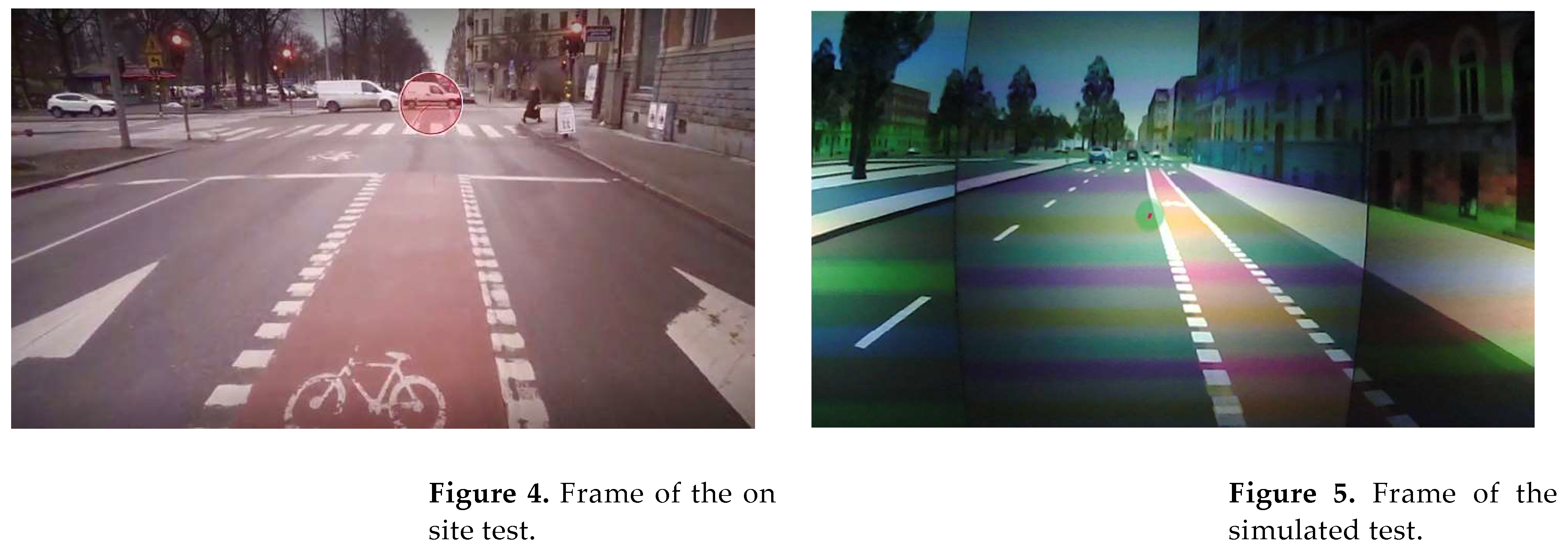
3. Discussion and results
3.1. On-site test
The on-site test shows interesting data in terms of attention. In particular, it has very high and approximately constant percentages for all the areas analysed. In detail, the attention rate of each zone decreases with the progress of the test (variation of 2/4%), highlighting that the participants are familiar with tools and road alignment. Indeed, the total duration of fixation begins at 934 sec for the first zone, goes up in zone 2 and begins to decrease from zone 3, then ends with values equal to 1197 sec in the last zone (Table 1). Referring to the trend of the percentages of each user, the behaviors adopted during the test are homogeneous; in fact, for each user, the percentage of inattention remains within a very narrow range, from a minimum of 7% to a maximum of 22%.
The highest attention rate recorded in zones 1A and 2 is 90% (SD=0.083). The category most attractive for users is infrastructure, in particular the road. 78% of the total attention frames, in fact, are focalized on the infrastructure; this shows that the participants mainly looked at the central area of the pavement to keep track of the route, avoiding obstacles and holes and trying to prevent dangerous interactions with other road users (Table 2). Considering their behaviour when a pedestrian passes through a crossing, 48% of users do not stop; quite the opposite, cyclists increase their speed to avoid the pedestrian, without paying particular attention to him. In fact, only 2 out of 20 users look at these weak road users and modulate their driving behavior, in order to give the right-of-way. Zone 2 also has a large number of traffic lights along the route. Nevertheless, participants did not pay much attention to intersections, recording only 4% of frames for the traffic lights decreasing to 2% for the pedestrian passage. This important result underlines the first critical point of the infrastructure that does not allow to focus the cyclists' attention on intersections, also recording that as many as 11% of these overcome the crossing having the red traffic light (Kircher and Ahlstrom, 2017).
Zone 3 and 1B are the lower attentive road sections of 10% and 14% respectively. The greatest number of frames is directed towards the GPS sensor (AVERAGE = 61%) placed in the handlebar with its path monitoring display (Table 3). Finally, to outline a cumulative figure on the attention of cyclists during the entire route, it is possible to identify 88% of attention (SD = 0.58) and 12% of inattention (SD = 0.59).
3.2. Simulated test
The test outputs in the bicycle simulator (Figure 6) report a high attention trend with an average fixation duration of 8.28 min (SD:0.02) over 10.33 min of the entire route (Table 4). Considering the different areas, there is a weighted average of attention equal to 85% in the 1A zone, 87% in zone 2, 81% in zone 3 and finally 83% in zone 1B. According to the sickness questionnaire, the lowest percentage of attention in zone 3 is justified by the rapid collapse of workloads as they pass by a promiscuous road cyclists-cars, to a stretch shared between cyclists and pedestrians. In fact, they do not feel fatigued, do not have vertigo or view and cognitive difficulties, unlike the remaining areas (Acerra et al., 2022). Although the categories of attention such as pedestrian crossing and traffic lights are poorly focused on by cyclists (AVERAGE=4%), users have a different subjective perception. In fact, the questionnaires highlight that, not only the traffic lights are visible but also they respect the traffic light phases in 87% of the cases (Table 5). On the other hand, analyzing the videos, it is possible to notice that 40% of cyclists overtake at the red light.
A second example that underlines the difference between objective and subjective perception is linked to a specific interaction in zone 2. In fact, a wheelchair has been programmed to pass over a no traffic light-controlled pedestrian crossing. The questionnaires show that 85% of users say they have enough time to brake safely to permit the crossing. By contrast, only 20% of cyclists stop to give the right of way.
The categories of inattention deal with 64% of frames dedicated to buildings and 31% to vegetation, such as trees, bushes and meadows (Table 6). Such distraction, localized in particular near the crossings (AVERAGE=61%), confirmation the ineffectiveness of such infrastructural elements.
In the analysis of inattention, it has been possible to identify cycling behavior that follows indices in contrast to average performance. User 8, in fact, has a higher percentage of frames focused on elements of inattention, about 57%. In particular, the user registers twice as many frames facing buildings as the street; in the same way, he observed the vegetation for a much longer time than the sidewalks. This objective evaluation is opposed by the perception of the user himself. In fact, in the questionnaire, he perceived to pay attention to the road, having a clear path to follow and in particular the intersections.
The results of the NASA TLX questionnaire suggest low average workload values both before (AVERAGE=4; SD=0.59) and after the test (AVERAGE=3.8; SD=0.91). Therefore, this perception is opposite to the objective evaluation carried out through frame-by-frame analysis, where the percentage of attention is high. Comparing the before and after conditions, moreover, it is noted a decrease in mental demand and temporal demand, so as to highlight a simplification of the level of difficulty cycling accompanied by rhythms of variation in the perception of the increasingly minor scenarios (Figure 7). The effort also turns out to be lower after the users have carried out the test as well as the frustration because they have perceived an increase of clarity of the path. The countertrend factors, on the other hand, are realized by physical demand and performance, which is perceived with greater when the test is finished.
3.3. Comparison
Comparing the data extrapolated in the site and in the simulator, it can be noticed that the course of the percentages of attention and inattention of every zone are not the same (Figure 8). In the on-site experiment, the attention rate shows a decreasing branch from the beginning to the end of the circuit, therefore recording a maximum value in the first zone (90%). This trend, which highlights not only an adaptation to the route but also a progressive increase in fatigue, is in contrast to the test data in the bicycle simulator. The results, in fact, show an oscillation of the degree of attention, which is significant, considering the use of the various areas. In fact, the highest values of attention are present in zone 2, where the user must interface with pedestrians, cyclists, vehicles and buses.
By performing a cumulative analysis of the attention data you notice the 4% difference between the site and simulator (p<0.03). This data differs from the bibliography (Shoman et al., 2018). It is expected, in fact, that users, in a closed space like that of the simulator, are less distracted as they do not suffer from the boundary conditions that you have in the real scenario. This, in fact, represents an ulterior important element in the evaluation of the same effectiveness of the tests, emphasizing that the simulation succeeds in reproducing faithfully the real scenario. This factor is further confirmed by the questionnaires, where 90% of cyclists believe that the simulated scenario and the bicycle itself allow them to feel like they are moving in reality (Shoman et al.,2020). Moreover, 80% of the participants, being enclosed by 7 screens that provide a wide field of view (FOV) and a lateral and rear view, underline that the graphic fluidity (with FPS never below 60) and the feeling of speed are perceived as the real one. Nonetheless, also in this case, it is possible to emphasize a discrepancy between objective evaluation and subjective perception, as the participants unconsciously perceive a higher level of safety within the laboratory which makes them more inclined to lose attention.
4. Conclusion
The proposed framework deals with the visual behavior of cyclists considering useful insights into the objective factor in evaluating their riding style. The experiments consist of one road test which includes different cycle tracks (promiscuous cycle and vehicle routes, with or without specific separation signals, pedestrian and cyclist path) and one simulated experiment. The campaign involved 40 participants who were equipped with a highly innovative tool, the Pupil Core. This eye-tracker allowed to record of a video characterized by a circle that focuses on the point of view of each user. The analytical approach uses the attribution and quantification of every single frame to a category such as: infrastructure, users, signs, background, or bicycle test. By defining the macro-categories of attention and inattention, it was also possible to quantify the trend for both experiments and then compare them.
First of all, the on-site test showed a low level of inattention, especially towards the subcategory of GPS, useful to keep track of the path to follow, but very often unclear to users. Pedestrian crossings are assessed as the main critical points of the infrastructure. Cyclists do not see them either when actors of the right of way, i.e. in bike crossings as they do not look at traffic lights while crossing, or when they should give priority to a pedestrian crossing. The test in the bicycle simulator, on the other hand, shows an index of inattention related to buildings, as users feel particularly attracted by this simulated environment full of real details. In this test, the on-site assessment of crossings is further confirmed by the simulation of a wheelchair crossing.
As many as 80% of users do not give precedence but increase its speed to overtake or completely ignore it. The comparison of the two tests reveals two important points in common: the high proportion of attention paid to the road and the definition of critical elements of the infrastructure. The first confirms the high road safety throughout the entire route as the elements of the infrastructure allow the cyclist to concentrate on his driving task. The second aspect, however, makes it possible to identify crossings as places where there is a greater risk of accidents.
The factor that most underlines the risk is the low perception of this critical point by users. In fact, only 20% of users approach the crossing slowing down to give the right way, while 80% say they have a correct behavior in the approach to this infrastructure element.
It is precisely the factors in common between the tests that allow to emphasize the validity of the use of the bicycle simulator. In fact, the simulator allows to get as close as possible to the real scenario, obtaining objective results very similar to each other providing visual sensations, vibration movement and noise.
Acknowledgments
This work was supported by the University of Bologna and the Gustave Eiffel University of Paris.
References
- Acerra, E.M.; Lantieri, C.; Simone, A.; Di Flumeri, G.; Borghini, G.; Babiloni, F.; Vignali, V. The Impact of the Adaptive Cruise Control on the Drivers’ Workload and Attention. 2022; Available at SSRN 4281921. [Google Scholar]
- Ahlstrom, C.; Kircher, K.; Kircher, A. A gaze-based driver distraction warning system and its effect on visual behavior. IEEE Transactions on Intelligent Transportation Systems 2013, 14, 965–973. [Google Scholar] [CrossRef]
- Alm, H.; Nilsson, L. Oool-4575(93)E0003-P Changes in driver behaviour as a function of handsfree mobile phones-a simulator study. Accid. Anal. and Prev. 1994. [Google Scholar] [CrossRef] [PubMed]
- Atkinson, J.E.; Hurst, P.M. Collisions between cyclists and motorists in New Zealand. Accident Analysis & Prevention 1983, 15, 137–151. [Google Scholar]
- Bao, S.; Flannagan, C.; Xiong, H.; Sayer, J. Eye glance behavior associated with cell-phone use: Examination with naturalistic driving data. In Proceedings of the Human Factors and Ergonomics Society; Human Factors an Ergonomics Society Inc., 2014; pp. 2112–2116. [Google Scholar] [CrossRef]
- Beratis, I.N.; Pavlou, D.; Papadimitriou, E.; Andronas, N.; Kontaxopoulou, D.; Fragkiadaki, S.; Yannis, G.; Papageorgiou, S.G. Mild Cognitive Impairment and driving: Does in-vehicle distraction affect driving performance? Accid Anal Prev 2017, 103, 148–155. [Google Scholar] [CrossRef] [PubMed]
- Bucchi, A.; Sangiorgi, C.; Vignali, V. Traffic Psychology and Driver Behavior. Procedia Soc Behav Sci 2012, 53, 972–979. [Google Scholar] [CrossRef]
- Bulling, A.; Duchowski, A.T.; Majaranta, P.; SIGCHI (Group: U.S.); ACM SIGMOBILE, Association for Computing Machinery. Special Interest Group on Spatial Information; Microsoft Research; ACM Digital Library. UbiComp (Conference) (13th: 2011: Beijing, C., n.d. PETMEI 11. In Proceedings of the 1st International Workshop on Pervasive Eye Tracking & Mobile Eye-Based Interaction, Beijing, China, 18 September 2011. [Google Scholar]
- Caird, J.K.; Willness, C.R.; Steel, P.; Scialfa, C. A meta-analysis of the effects of cell phones on driver performance. Accid Anal Prev 2008, 40, 1282–1293. [Google Scholar] [CrossRef]
- Cao, A.; Chintamani, K.K.; Pandya, A.K.; Ellis, R.D. NASA TLX: Software for assessing subjective mental workload. Behav Res Methods 2009, 41, 113–117. [Google Scholar] [CrossRef]
- Cheng, S. The Research Framework of Eye-tracking Based Mobile Device Usability Evaluation. In Proceedings of the PETMEI ’11: 1st international workshop on pervasive eye tracking & mobile eye-based interaction; 2011; pp. 21–26. [Google Scholar] [CrossRef]
- Costa, M.; Bonetti, L.; Vignali, V.; Bichicchi, A.; Lantieri, C.; Simone, A. Driver’s visual attention to different categories of roadside advertising signs. Appl Ergon 2019, 78, 127–136. [Google Scholar] [CrossRef]
- Crundall, D.; Underwood, G.; Chapman, P. Driving experience and the functional field of view. Perception 1999, 28, 1075–1088. [Google Scholar] [CrossRef]
- Crundall, D.; van Loon, E.; Underwood, G. Attraction and distraction of attention with roadside advertisements. Accid Anal Prev 2006, 38, 671–677. [Google Scholar] [CrossRef]
- De Waard, D.; Westerhuis, F.; Lewis-Evans, B. More screen operation than calling: The results of observing cyclists’ behaviour while using mobile phones. Accid Anal Prev 2015, 76, 42–48. [Google Scholar] [CrossRef] [PubMed]
- Decker, J.S.; Stannard, S.J.; McManus, B.; Wittig, S.M.O.; Sisiopiku, V.P.; Stavrinos, D. The Impact of Billboards on Driver Visual Behavior: A Systematic Literature Review. Traffic Inj Prev 2015, 16, 234–239. [Google Scholar] [CrossRef] [PubMed]
- Dukic, T.; Ahlstrom, C.; Patten, C.; Kettwich, C.; Kircher, K. Effects of Electronic Billboards on Driver Distraction. Traffic Inj Prev 2013, 14, 469–476. [Google Scholar] [CrossRef] [PubMed]
- Fitch, G.M.; Bartholomew, P.R.; Hanowski, R.J.; Perez, M.A. A. Drivers' visual behavior when using handheld and hands-free cell phones. Journal of safety research 2015, 54, 105–e29. [Google Scholar] [CrossRef] [PubMed]
- Gadsby, A.; Watkins, K. Instrumented bikes and their use in studies on transportation behaviour, safety, and maintenance. Transp Rev 2020, 40, 774–795. [Google Scholar] [CrossRef]
- Ghasemi, N.; Acerra, E.M.; Lantieri, C.; Simone, A.; Rupi, F.; Vignali, V. Urban Mid-Block Bicycle Crossings: The Effects of Red Colored Pavement and Portal Overhead Bicycle Crossing Sign. Coatings 2022, 12, 150. [Google Scholar] [CrossRef]
- Ghasemi, N.; Acerra, E.; Vignali, V.; Lantieri, C.; Simone, A.; Imine, H. Road Safety Review update by using innovative technologies to investigate driver behaviour. Transportation research procedia 2020, 45, 368–375. [Google Scholar] [CrossRef]
- Godley, S.T.; Triggs, T.J.; Fildes, B.N. Driving simulator validation for speed research. Accident Analysis and Prevention 2002. [CrossRef]
- Gordon, C. Driver distraction: An initial examination of the ‘attention diverted by’contributory factor codes from crash reports and focus group research on perceived risks. no. code 2005, 350, 1–14. [Google Scholar]
- Hancock, P.A.; Lesch, M.; Simmons, L. The distraction effects of phone use during a crucial driving maneuver. Accident Analysis and Prevention 2003.
- He, Q.; Fan, X.; Ma, D. Full bicycle dynamic model for interactive bicycle simulator. J Comput Inf Sci Eng 2005, 5, 373–380. [Google Scholar] [CrossRef]
- Herpers, R.; Heiden, W.; Kutz, M.; Scherfgen, D.; Hartmann, U.; Bongartz, J.; Schulzyk, O. FIVIS bicycle simulator: an immersive game platform for physical activities. In Proceedings of the 2008 Conference on Future Play: Research, Play, Share; 2008; pp. 244–247. [Google Scholar]
- Jiang, K.; Yang, Z.; Feng, Z.; Sze, N.N.; Yu, Z.; Huang, Z.; Chen, J. Effects of using mobile phones while cycling: A study from the perspectives of manipulation and visual strategies. Transp Res Part F Traffic Psychol Behav 2021, 83, 291–303. [Google Scholar] [CrossRef]
- Kang, H.B. Various approaches for driver and driving behavior monitoring: A review. In Proceedings of the IEEE International Conference on Computer Vision; Institute of Electrical and Electronics Engineers Inc., 2013; pp. 616–623. [Google Scholar] [CrossRef]
- Kass, S.J.; Cole, K.S.; Stanny, C.J. Effects of distraction and experience on situation awareness and simulated driving. Transp Res Part F Traffic Psychol Behav 2007, 10, 321–329. [Google Scholar] [CrossRef]
- Khan, M.Q.; Lee, S. Gaze and eye tracking: Techniques and applications in ADAS. Sensors (Switzerland) 2019. [CrossRef] [PubMed]
- Kircher, K.; Ahlstrom, C. Minimum Required Attention: A Human-Centered Approach to Driver Inattention. Hum Factors 2017, 59, 471–484. [Google Scholar] [CrossRef]
- Kovácsová, N.; Cabrall, C.D.D.; Antonisse, S.J.; de Haan, T.; van Namen, R.; Nooren, J.L.; Schreurs, R.; Hagenzieker, M.P.; de Winter, J.C.F. Cyclists’ eye movements and crossing judgments at uncontrolled intersections: An eye-tracking study using animated video clips. Accid Anal Prev 2018, 120, 270–280. [Google Scholar] [CrossRef]
- Kwon, D.S.; Yang, G.H.; Lee, C.W.; Shin, J.C.; Park, Y.; Jung, B.; Lee, D.Y.; Lee, K.; Han, S.H.; Yoo, B.H.; et al. KAIST interactive bicycle simulator. Proc IEEE Int Conf Robot Autom 2001, 3, 2313–2318. [Google Scholar] [CrossRef]
- Lantieri, C.; Costa, M.; Vignali, V.; Acerra, E.M.; Marchetti, P.; Simone, A. Flashing in-curb LEDs and beacons at unsignalized crosswalks and driver’s visual attention to pedestrians during nighttime. Ergonomics 2021, 64, 330–341. [Google Scholar] [CrossRef]
- Liang, Y.; Lee, J.D. Combining cognitive and visual distraction: Less than the sum of its parts. Accid Anal Prev 2010, 42, 881–890. [Google Scholar] [CrossRef]
- Mantuano, A.; Bernardi, S.; Rupi, F. Cyclist gaze behavior in urban space: An eye-tracking experiment on the bicycle network of Bologna. Case Stud Transp Policy 2017, 5, 408–416. [Google Scholar] [CrossRef]
- Massey, H.S.; Whitehead, A.E.; Marchant, D.; Polman, R.C.; Williams, E.L. An investigation of expertise in cycling: Eye tracking, Think Aloud and the influence of a competitor. Psychol Sport Exerc 2020, 49. [Google Scholar] [CrossRef]
- Nabatilan, L.B.; Aghazadeh, F.; Nimbarte, A.D.; Harvey, C.C.; Chowdhury, S.K. Effect of driving experience on visual behavior and driving performance under different driving conditions. Cognition, Technology and Work 2012, 14, 355–363. [Google Scholar] [CrossRef]
- O’Hern, S.; Oxley, J.; Stevenson, M. Validation of a bicycle simulator for road safety research. Accid Anal Prev 2017, 100, 53–58. [Google Scholar] [CrossRef] [PubMed]
- Pai, C.W.; Jou, R.C. Cyclists’ red-light running behaviours: An examination of risk-taking, opportunistic, and law-obeying behaviours. Accid Anal Prev 2014, 62, 191–198. [Google Scholar] [CrossRef]
- Pieroni, A.; Lantieri, C.; Imine, H.; Simone, A. Light vehicle model for dynamic car simulator. Transport 2016, 31, 242–249. [Google Scholar] [CrossRef]
- Planek, T.W.; Sinelnikov, S.; Thomas, J.; Kolosh, K.; Porretta, K. Letter from the Editors - Fourth international symposium on naturalistic driving research. J Safety Res. 2015. [Google Scholar] [CrossRef]
- Räsänen, M.; Koivisto, I.; Summala, H. Car Driver and Bicyclist Behavior at Bicycle Crossings Under Different Priority Regulations. Journal of Safety Research 1999. [CrossRef]
- Recarte, M.A.; Nunes, L.M. Effects of Verbal and Spatial-Imagery Tasks on Eye Fixations While Driving. J Exp Psychol Appl 2000, 6, 31–43. [Google Scholar] [CrossRef]
- Recarte, M.A.; Nunes, L.M. Mental Workload While Driving: Effects on Visual Search, Discrimination, and Decision Making. J Exp Psychol Appl 2003, 9, 119–137. [Google Scholar] [CrossRef]
- Regan, M.A.; Hallett, C.; Gordon, C.P. Driver distraction and driver inattention: Definition, relationship and taxonomy. Accid Anal Prev 2011, 43, 1771–1781. [Google Scholar] [CrossRef]
- Ryerson, M.S.; Long, C.S.; Fichman, M.; Davidson, J.H.; Scudder, K.N.; Kim, M.; Katti, R.; Poon, G.; Harris, M.D. Evaluating cyclist biometrics to develop urban transportation safety metrics. Accid Anal Prev 2021, 159. [Google Scholar] [CrossRef] [PubMed]
- Schepers, J.P.; Kroeze, P.A.; Sweers, W.; Wüst, J.C. Road factors and bicycle-motor vehicle crashes at unsignalized priority intersections. Accid Anal Prev 2011, 43, 853–861. [Google Scholar] [CrossRef] [PubMed]
- Schepers, P.; den Brinker, B. What do cyclists need to see to avoid single-bicycle crashes? Ergonomics 2011, 54, 315–327. [Google Scholar] [CrossRef] [PubMed]
- Shinar, D.; Tractinsky, N.; Compton, R. Effects of practice, age, and task demands, on interference from a phone task while driving. Accid Anal Prev 2005, 37, 315–326. [Google Scholar] [CrossRef] [PubMed]
- Shoman, M.; Imine, H. Subjective validity of bicycle simulators. In Proceedings of the Ninth International Conference on Advances in Vehicular Systems, Technologies and Applications; 2020; pp. 1–6. [Google Scholar]
- Shoman, M.; Imine, H.; Johansson, K.; Wallqvist, V. Bicycle instrumentation and analysis of the output signals. Highlights of Vehicles, under submission. 2022. [Google Scholar]
- Shoman, M.; Imine, H. Bicycle Simulator Improvement and Validation. IEEE Access 2021, 9, 55063–55076. [Google Scholar] [CrossRef]
- Shoman, M.; Simone, A.; Vignali, V. Looking behavior to vertical road signs on rural roads. MOJ Civil Engineering 2018, 4, 75–79. [Google Scholar]
- Stavrinos, D.; Mosley, P.R.; Wittig, S.M.; Johnson, H.D.; Decker, J.S.; Sisiopiku, V.P.; Welburn, S.C. Visual behavior differences in drivers across the lifespan: A digital billboard simulator study. Transp Res Part F Traffic Psychol Behav 2016, 41, 19–28. [Google Scholar] [CrossRef]
- Törnros, J. Driving behaviour in a real and a simulated road tunnel—a validation study. Accident Analysis & Prevention 1998, 30, 497–503. [Google Scholar]
- Vansteenkiste, P.; Zeuwts, L.; Cardon, G.; Philippaerts, R.; Lenoir, M. The implications of low quality bicycle paths on gaze behavior of cyclists: A field test. Transp Res Part F Traffic Psychol Behav 2014, 23, 81–87. [Google Scholar] [CrossRef]
- Vignali, V.; Cuppi, F.; Acerra, E.; Bichicchi, A.; Lantieri, C.; Simone, A.; Costa, M. Effects of median refuge island and flashing vertical sign on conspicuity and safety of unsignalized crosswalks. Transportation research part F: traffic psychology and behaviour 2019, 60, 427–439. [Google Scholar] [CrossRef]
- Villing, J. Towards Dialogue Strategies for Cognitive Workload Man. Accident Analysis and Prevention 2015, 41, 924–930. [Google Scholar]
- Von Stülpnagel, R. Gaze behavior during urban cycling: Effects of subjective risk perception and vista space properties. Transp Res Part F Traffic Psychol Behav 2020, 75, 222–238. [Google Scholar] [CrossRef]
- Von Stülpnagel, R. Gaze behavior during urban cycling: Effects of subjective risk perception and vista space properties. Transp Res Part F Traffic Psychol Behav 2020, 75, 222–238. [Google Scholar] [CrossRef]
- Walker, G.H.; Stanton, N.A.; Chowdhury, I. Self Explaining Roads and situation awareness. Saf Sci 2013, 56, 18–28. [Google Scholar] [CrossRef]
- Walker, I. Signals are informative but slow down responses when drivers meet bicyclists at road junctions. Accid Anal Prev 2005, 37, 1074–1085. [Google Scholar] [CrossRef]
- Walker, I. Drivers overtaking bicyclists: Objective data on the effects of riding position, helmet use, vehicle type and apparent gender. Accid Anal Prev 2007, 39, 417–425. [Google Scholar] [CrossRef]
- Wang, Y.; Bao, S.; Du, W.; Ye, Z.; Sayer, J.R. Examining drivers’ eye glance patterns during distracted driving: Insights from scanning randomness and glance transition matrix. J Safety Res 2017, 63, 149–155. [Google Scholar] [CrossRef]
- Wu, C.; Yao, L.; Zhang, K. The red-light running behavior of electric bike riders and cyclists at urban intersections in China: An observational study. Accid Anal Prev 2012, 49, 186–192. [Google Scholar] [CrossRef]
Figure 1.
Localization of the route and distinction in different zones.
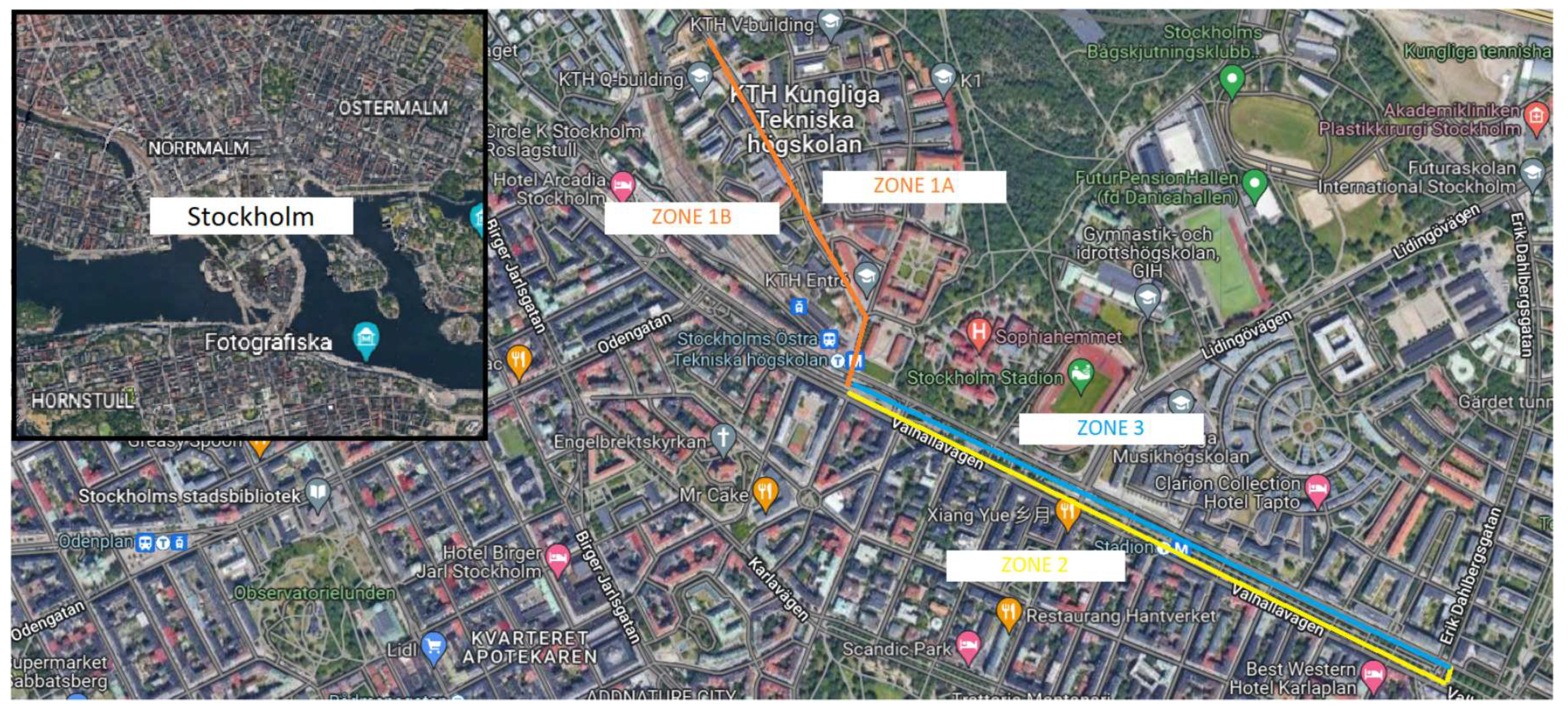
Figure 2.
Pupil Core.
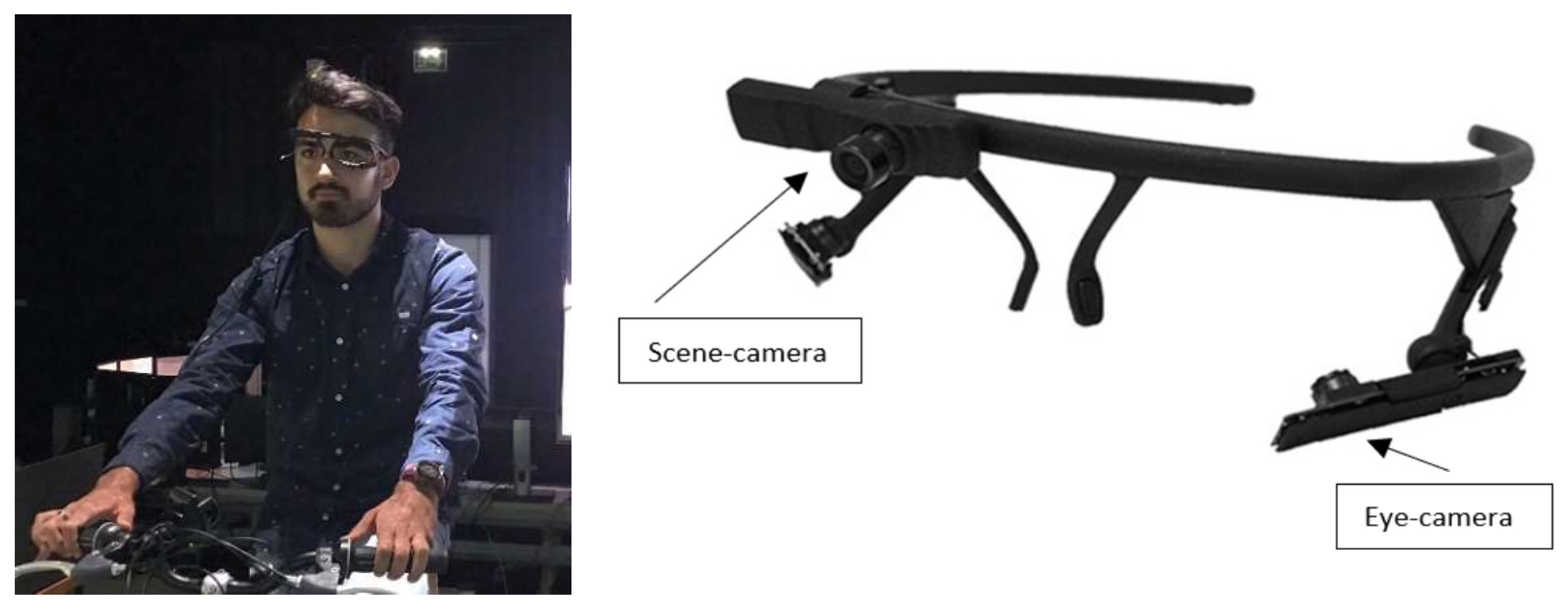
Figure 3.
Calibration phase.

Figure 6.
Simulated Test.
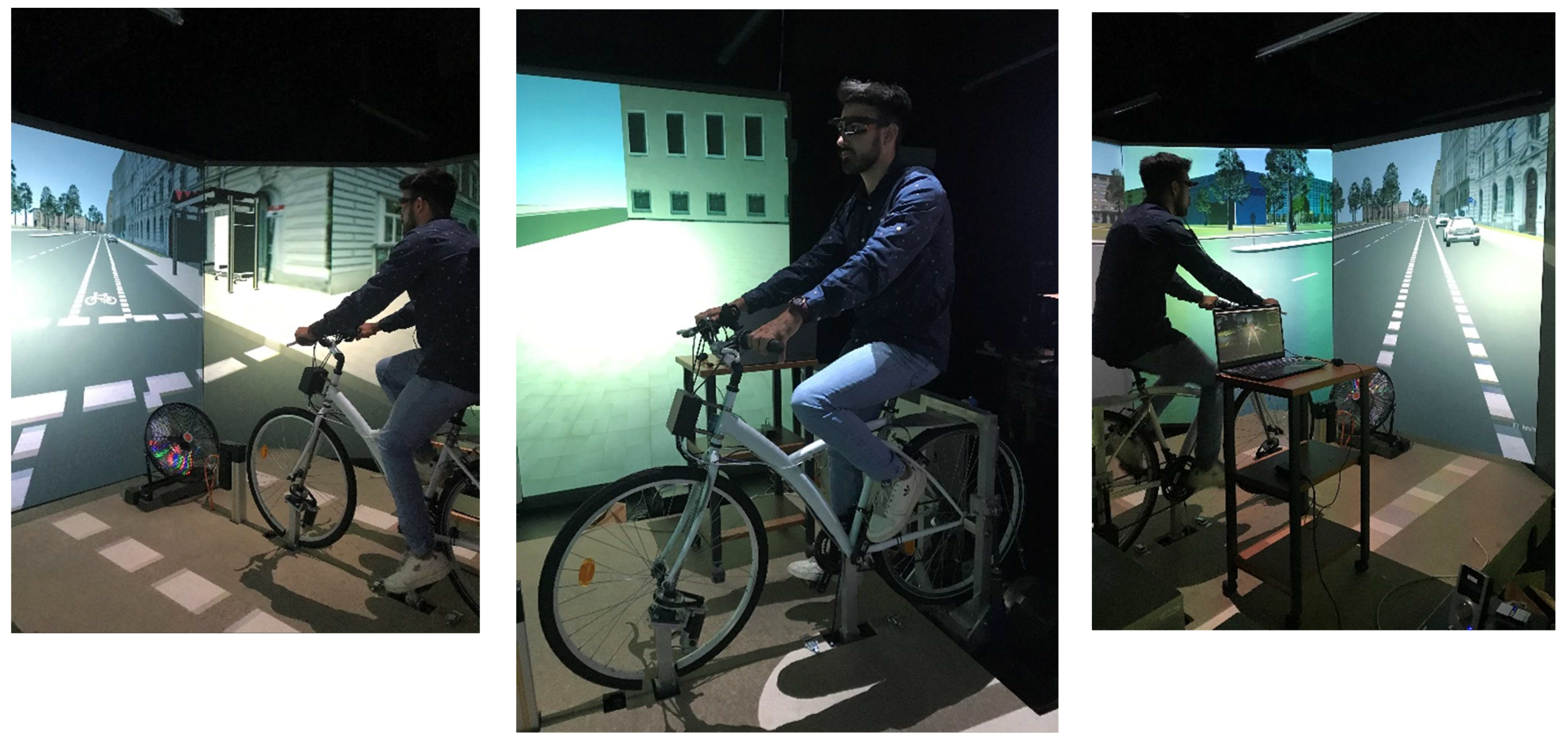
Figure 7.
Outcomes of NASA questionnaire comparing the values before and after the experimentation.
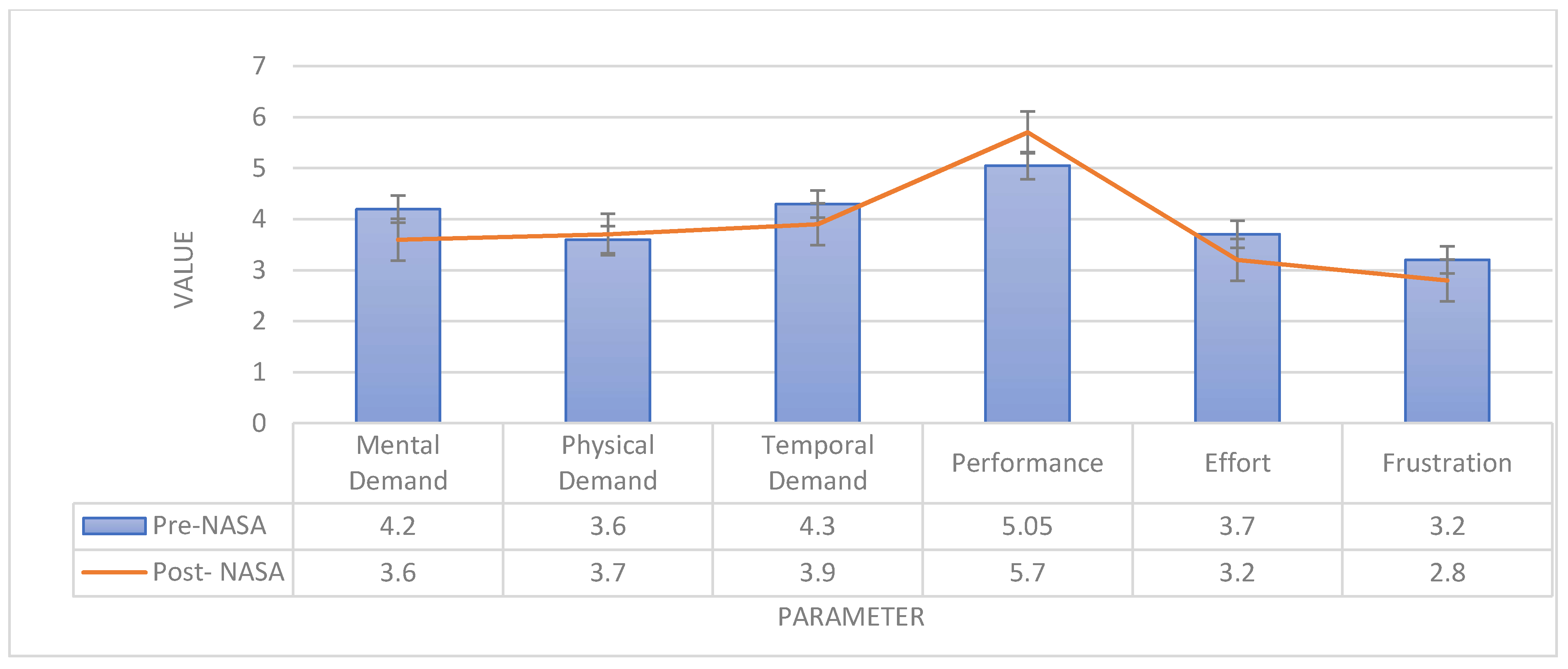
Figure 8.
Comparison between the percentage of attention for each zona.
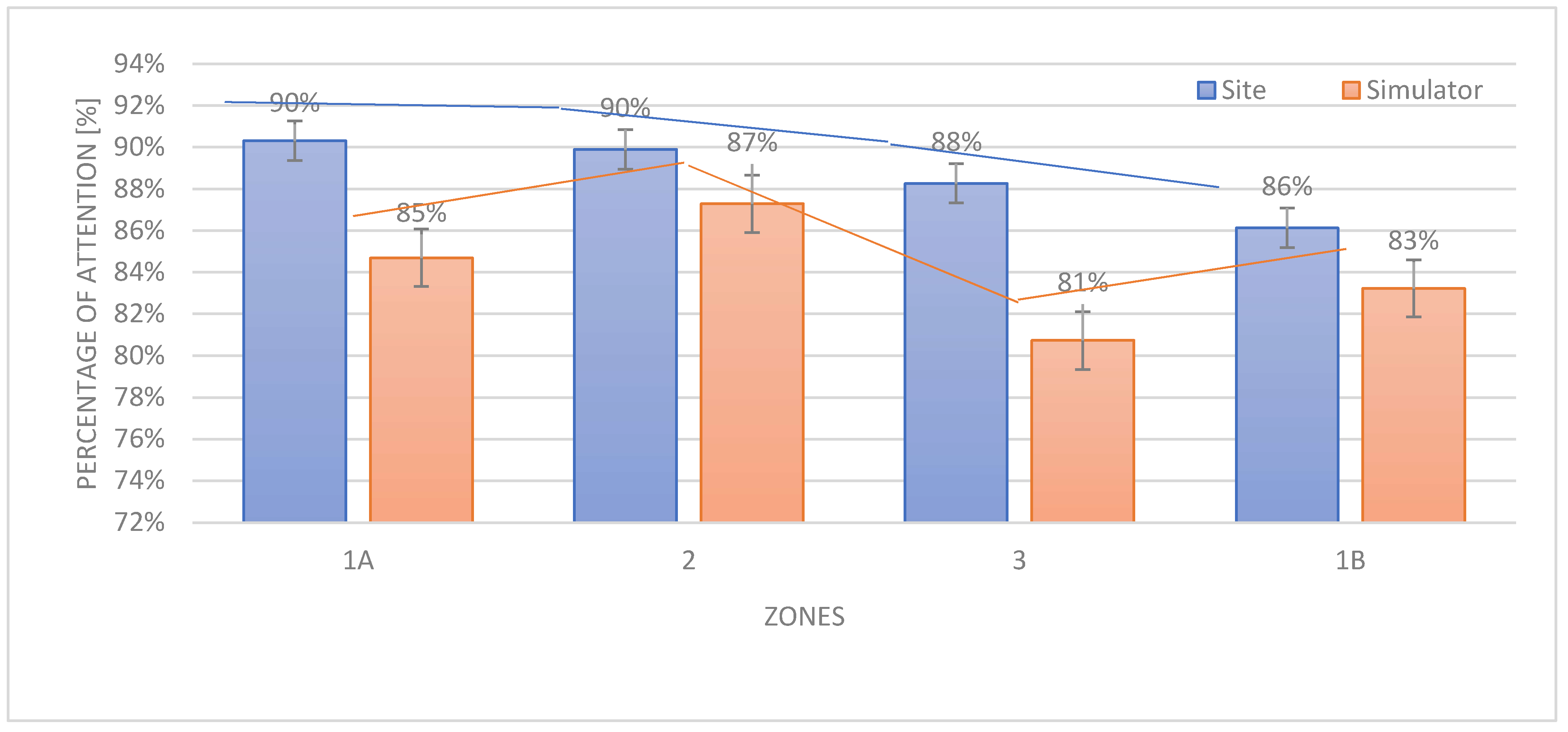
Table 1.
Total fixation and duration considering the attention and the inattention.
| Zones | Total frames | Total fixation duration [sec] | Fixation duration of attention [sec] | Fixation duration of inattention [sec] |
|---|---|---|---|---|
| 1A | 23359 | 934.36 | 845.32 | 89.04 |
| 2 | 50545 | 2021.8 | 1756.34 | 265.46 |
| 3 | 44412 | 1776.48 | 1547.36 | 229.13 |
| 1B | 29924 | 1196.96 | 1032.01 | 164.93 |
Table 2.
Categories of attention.
| Categories | Total frames | Total fixation duration [sec] | Average Percentage [%] |
|---|---|---|---|
| Sidewalk | 3013 | 121 | 2 |
| Street | 101635 | 4065 | 78 |
| Car | 5916 | 237 | 5 |
| Parked car | 2818 | 113 | 2 |
| Pedestrian | 5617 | 225 | 4 |
| Bicycle | 1417 | 57 | 1 |
| Horizontal Signs | 803 | 32 | 1 |
| Vertical Signs | 755 | 30 | 1 |
| Pedestrian passage | 2138 | 86 | 2 |
| Traffic light | 5414 | 217 | 4 |
Table 3.
Categories of inattention.
| Categories | Total frames | Total fixation duration [sec] | Average Percentage [%] |
|---|---|---|---|
| Buildings | 3066 | 123 | 16 |
| Vegetation | 774 | 31 | 4 |
| Street lamps | 601 | 25 | 3 |
| Sky | 7 | 0.28 | 0 |
| Handlebar | 2136 | 85 | 11 |
| Pedals | 721 | 29 | 4 |
| Gps | 11410 | 456 | 61 |
Table 4.
Total fixation and duration considering the attention and the inattention.
| Zones | Total frames | Total fixation duration [sec] | Fixation duration of attention [sec] | Fixation duration of inattention [sec] |
|---|---|---|---|---|
| 1A | 12168 | 487 | 386 | 101 |
| 2 | 24315 | 973 | 813 | 159.48 |
| 3 | 16712 | 668 | 492 | 176.24 |
| 1B | 8771 | 351 | 297 | 53.6 |
Table 5.
Categories of attention.
| Categories | Total frames | Total fixation duration [sec] | Average Percentage [%] |
|---|---|---|---|
| Sidewalk | 19203 | 768 | 9 |
| Street | 159839 | 6394 | 78 |
| Car | 9355 | 374 | 5 |
| Parked car | 4053 | 162 | 2 |
| Pedestrian | 3272 | 131 | 2 |
| Bicycle | 2026 | 81 | 1 |
| Horizontal Signs | 0 | 0 | 0 |
| Vertical Signs | 25 | 1 | 0 |
| Pedestrian passage | 2782 | 111 | 1 |
| Traffic light | 5476 | 219 | 3 |
Table 6.
Categories of inattention.
| Categories | Total frames | Total fixation duration [sec] | Average Percentage [%] |
|---|---|---|---|
| Buildings | 23795 | 952 | 64 |
| Vegetation | 11535 | 461 | 31 |
| Street lamps | 45 | 2 | 0 |
| Sky | 1106 | 44 | 3 |
| Handlebar | 744 | 30 | 2 |
| Pedals | 17 | 0.68 | 0 |
| Gps | 0 | 0 | 0 |
Disclaimer/Publisher’s Note: The statements, opinions and data contained in all publications are solely those of the individual author(s) and contributor(s) and not of MDPI and/or the editor(s). MDPI and/or the editor(s) disclaim responsibility for any injury to people or property resulting from any ideas, methods, instructions or products referred to in the content. |
© 2023 by the authors. Licensee MDPI, Basel, Switzerland. This article is an open access article distributed under the terms and conditions of the Creative Commons Attribution (CC BY) license (http://creativecommons.org/licenses/by/4.0/).
Copyright: This open access article is published under a Creative Commons CC BY 4.0 license, which permit the free download, distribution, and reuse, provided that the author and preprint are cited in any reuse.
MDPI Initiatives
Important Links
© 2024 MDPI (Basel, Switzerland) unless otherwise stated











